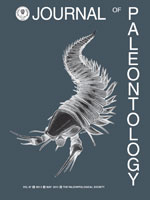A new acanthocladiid bryozoan genus from the Permian of the Glass Mountains of Texas, U.S.A., reveals a distinctive morphology and a growth pattern unique amongst members of the extinct stenolaemate Order Fenestrata. Adlatipora fossulata n. gen. n. sp. forms small pinnate expansions with moderately robust main stems and shorter laterally placed pinnae. Colonies developed from small basal discs that exhibit a unique multilayered skeletal structure, from which a circlet of first generation autozooids bud from the ancestrula; these become the bases of branches. In Adlatipora autozooecia are organized into diagonal rows that alternate along branches and are separated into right-handed or left-handed forms. A fossula is developed from the distal margin of autozooecial apertures. Proximal pores are located adjacent to autozooecial apertures and are remnants of fossulae. These pores probably acted as an anal pore providing a passageway for fecal products.
How to translate text using browser tools
1 May 2013
Adlatipora, A Distinctive New Acanthocladiid Bryozoan from the Permian of the Glass Mountains, Texas, U.S.A., and its Bearing on Fenestrate Astogeny and Growth
T. Gary Gautier,
Patrick N. Wyse Jackson,
Frank K. McKinney
ACCESS THE FULL ARTICLE

Journal of Paleontology
Vol. 87 • No. 3
May 2013
Vol. 87 • No. 3
May 2013




